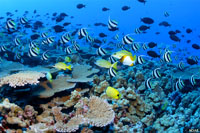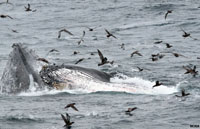
Oceanography 101 |
Return to class home page |
Chapter 14 - Marine Environments |
Marine communities include different feeding (trophic) levels:
The term food chain is defined the hierarchical series of organisms that are each dependent on the next as a source of food. However, nature provides complexity that is better explained as a food web. A food web may have a variety of food chains that move energy and nutrients through an ecosystem. For instance, small or microscopic offspring may start as primary or secondary consumers when they are small, but they may become tertiary consumers if they survive to become large adult forms. |
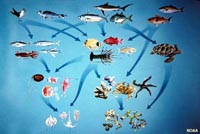 Fig. 14-2. Food chains and food webs can be complex. |
Definitions* Planktonic: applies to organisms that float or drift with flowing currents (zooplankton are animals, phytoplankton are plants.)* Nektonic: applies to organism that actively move swim by their own means. * Pelagic: means relating to the open sea, chiefly shallow layers. Planktonic and nektonic organisms live in open water (more in chapter 16).
* Terrestrial refers to land environments (desert, mountain, rivers, etc) - some marine predators live in terrestrial environments. |
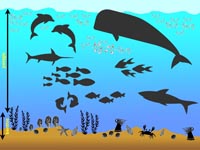 Fig. 14-3. Benthic and pelagic zones. 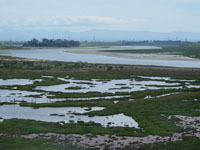 Fig. 14-4. Elkhorn slough, a tidal estuary in central California, has littoral, estuarine, neritic, and limnetic sub environments. |
Natural factors influencing marine life: |
|||||||||||||
|
a) TemperatureTemperature governs the rate chemical and metabolic rates especially in cold-blooded organisms.Many organisms are sensitive to changes in temperature and this results in species zonation. Example—Different species of sharks: Sharks can be classified as tropical, temperate, or polar, depending on the surface temperature of the ocean region they inhabit.
|
 Fig. 14-6. Hammerhead sharks live in tropical waters.  Fig. 14-7. Great white sharks live in temperate regions. 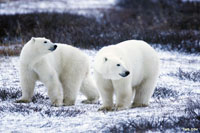 Fig. 14-8. Polar bears are homeothermic and adapted to living on arctic ice flows. |
b) SalinitySalinity in the open ocean is typically in a tolerable range for most marine creatures living in normal seawater (about 3.5‰ [ppt]). However, salinity is variable near landmasses (i.e.: tide pools, river outlets and with depth).Different organisms have different tolerances to salinity changes. For examples, some bull sharks can tolerate both freshwater and marine water settings. Oysters can't tolerate normal seawater because of predation and food supply. If drought shuts down the supply of freshwater, the water where the oysters are attached to the seabed may get too salty. Many of the predators that feed on oysters can only tolerate normal seawater, and will only move in to feed on oysters when highest tides or storm surges flood oyster beds with normal seawater conditions. |
 Fig. 14-9. Bull shark |
 Fig. 14-10. Oysters |
c) Water transparencyWater has a high transparency. So many organisms use different strategies to survive predation.Counter shading or camouflaging help organisms hide from predators. • Animals that display counter shading are typically dark colored on top and light colored underneath. • Animals that use camouflaging typically have skin or scales that match the habitat where they live and feed. Migration into darker areas during the day and lighter areas at dawn and dusk is another means of survival. Another consideration is clarity for photosynthesis. • Photic zone: The upper part of the ocean where sunlight penetrates (down to ~3,300 feet in very clear water!). • Euphotic Zone: upper ½ of photic zone where most primary production occurs. |
 Fig. 14-11. Trout displaying counter shading. 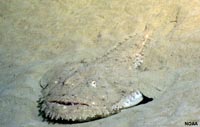 Fig. 14-12. Goosefish displaying camouflaging. |
d) NutrientsNutrients: are not "food," but are more like vitamins and minerals (fertilizer) essential to life functions.• Aids in the production of food (primary production). • Nutrients are essential to support photosynthesis—the process that provides sugars (energy) to support all other life processes. • There are many more intermediate processes requiring nutrients to produce other complex organic compounds (proteins, carbohydrates, fats, etc). Sources of Nutrients: Upwelling and continental weathering & erosion Primary nutrients: nitrates and phosphates Secondary = minerals (elements): calcium, iron, zinc, sodium, and many others. |
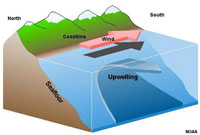 Fig. 14-13. Upwelling brings nutrients to the surface where they are utilized in primary production. |
e) pH (acidity and alkalinity)Seawater averages about 8.1 on a scale from 1 – 14 (1 is acidic, 14 is basic, and 7 is neutral). Pure water is neutral.Seawater is a buffered system meaning it is controlled in a range. If it gets too acidic it dissolves CaCO3, if its too basic it precipitates CaCO3. Seawater becomes slightly more acidic near the CCD (carbonate compensation depth). Animals with carbonate shells and tests need slightly basic (or alkaline) water in order to precipitate and maintain their shells. This is a potentially HUGE problems for the oceans with the increasing accumulation of CO2 in the atmosphere and oceans. Adding CO2 increases the acidity of seawater, lowering its pH to levels below 8.1, causing shells to dissolve. |
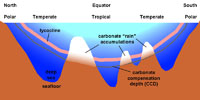 Fig. 14-14. Carbonate compensation depth (CCD) is where calcium carbonate precipitation and dissolution are equal. Below the CCD calcium carbonate dissolves. Fig. 14-14. Carbonate compensation depth (CCD) is where calcium carbonate precipitation and dissolution are equal. Below the CCD calcium carbonate dissolves. |
f) PressurePressure is the same inside an organism as outside.Organisms at great depths must be able to withstand great internal pressures. Many species of fish have gas-filled bladders in order to maintain buoyancy. Sperm whales hold the deep diving record for cetaceans at 3050m (10,000 ft). They can dive for over one hour in search of their main prey—squid and some fish. Humans get the bends if they rise to the surface too quickly (causing nitrogen to boil out of the blood). The same happens to deep water fish when they are brought to the surface. |
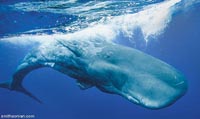 Fig. 14-15. Sperm whales can dive to great depths (thousands of feet) in search of food. |
 Fig. 14-16. Nautilus controls pressure in it shell and changes its buoyancy. |
g) Dissolved gasesThere must be sufficient CO2 for plants and O2 for animals or they must: move, adapt or die.Most ocean pollutants remove or lower the ability of seawater to hold CO2 or O2. Hypoxia and eutrophification are discussed in chapter 8). |
 Fig. 14-17. Fish killed by hypoxia (lack of O2). |
h) Environmental StabilityThe open ocean is generally a very stable environment compared to shallow and nearshore environments where the factors listed above may vary wildly with weather changes and other natural and artificial causes, both physical or biological in nature. Destabilizing forces include the impacts of superstorms, undersea landslides (causing turbidity flows), and hypoxia. Reefs and coastal ecosystems can be destroyed by the effects of hurricanes, but like wildfire on land, sea life can and will re-establish itself if the physical factors (described above) normalize. Coastal communities (ecosystems) can be heavily damaged by superstorms, but many species have evolved means to adapt to occasional events, and even take advantage of the aftermath. |
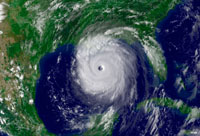 Fig. 14-18. Hurricane Katrina |
Biological factors:i) Competition for mates, food, and space:• competition may be between members of a species or between species.j) Predators:• too many predators can wipe out a community; not enough predators cause population explosions, resource exhaustion, and collapse. |
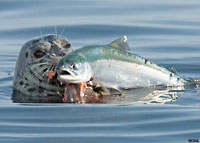 Fig. 14-19. Predator and prey (seal with fish meal). |
Seasonal Impacts of Food Resources in the Marine EnvironmentPrimary productivity is a primarily function of sunlight an available nutrients. Figure 14-20 shows the primary productivity of the three zones: tropical, temperate, and polar. Impacts on ConsumersPrimary, secondary, and tertiary consumers follow the cycles of primary productivity described above. A proliferation of zooplankton (primary consumers) occurs when their food (phytoplankton) becomes increasingly available. Zooplankton populations grow at the ultimate expense of the phytoplankton, and their populations peak, phytoplankton first, then zooplankton next. Secondary and tertiary consumer populations consume these recourses, and then migrate to search of other sources of food following the blooms in productivity northward in the spring and then returning south for the winter.Figure 14-21 compares the biomass of phytoplankton and zooplankton for the tropical, temperate, and polar zones through the months of year. Figure 14-22 compares the availability of nutrients and sunlight with biomass of phytoplankton and zooplankton for the temperate zone through seasons of the year. |
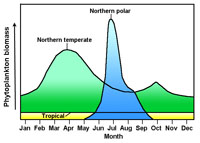 Fig. 14-20. Primary productivity in 3 zones.  Fig. 14-21. Plankton biomass by season in three zones. 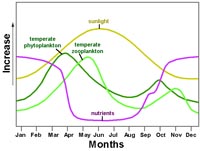 Fig. 14-22. Temperate zone productivity by seasons. Fig. 14-22. Temperate zone productivity by seasons. |
Divisions in the Marine Environment |
|
The Pelagic (open sea) environment is divided into the Neritic and Oceanic Provinces. Neritic (nearshore zone): Extends from shore with water less than 200 meters. It is subdivided into two zones: * Littoral (intertidal) zone: Interval between high and low tides. * Sub-littoral zone: Below the littoral zone to a depth of 200 meters. |
 Fig. 14-23. Coral reef in the neritic zone. |
Oceanic Provinces (based on depth)* Epipelagic: Water less than 200 meters* Mesopelagic: Water between 200 and 1000meters * Bathypelagic: Water between 1000 and 4000meters * Abyssopelagic: Water deeper than 4000 meters * Hadal: Depths below 6000 meters in deep sea trenches |
 Fig. 14-24. Depth zones |
| Sunlight penetration has its own divisions (Figure 14-25): * Photic zone: The upper part of the ocean where sunlight penetrates * Euphotic Zone: upper ½ of photic zone (usually to about 100 meters) * Dysphotic Zone: lower ½ of photic zone * Aphotic Zone: No light penetrates |
 Fig. 14-25. Photic Zones |
Zoning and Extinction in Marine CommunitiesBoth physical and biological factors result in zoning of organisms in a specific environment.Each group of organisms are affected by physical and biological factors (listed above). These conditions exist within geographically definable areas ranging from large (entire oceans) to micro environments (such as a rock outcrop on a beach). Extinction results when all members of a species dies off. Die offs happen when a local community is disrupted by changes in physical and biological factors. A species will survive when those factors return to tolerable conditions, and a nearby population can supply offspring to repopulate a location. With climate change, many areas are loosing species, causing local extinctions. Another factor is the introduction of non-native species that either out-compete native species, or modify the environment that make a habitat intolerable for survival of native species. |
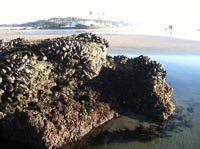 Fig. 14-26. A lone rock on a beach is an example of a micro environment. |
Carrying Capacity in Marine CommunitiesCarrying capacity is the stable number of individuals in a community. Carrying capacity has limiting factors including living space, food availability, and the physical and biological factors (previously discussed). For example prey and predator populations have limits within a geographic area.
Changes in physical and biological factors create opportunity and misfortune/bad luck, operating under natural selection (Adapt, move, or die!) Local die-offs happen frequently. Die offs occur because of seasonal changes (warm vs. cold), changes on food supply, predation, major storms, or any of the other natural physical or biological factors that change in an environmental setting. Species that survive these events have adaptations that allow them to survive, such has having abilities such as migration, hibernation, or producing seeds or eggs that can survive and create a new generation of offspring even when all adult members of a species are wiped by a seasonal or catastrophic event. Many species will migrate from suitable birthing grounds in one region to another location with the capacity to feed a population in another. Examples include migrations of many birds, whales, and other animals that migrate from the tropical regions in the winter season, to polar regions when the receive the greatest sunlight (summer in the northern hemisphere; winter in the southern hemisphere). Survival or Extinction (Past and Present)When all viable reproducing members of a species or community of species die off, it is extinction. Extinction is a natural process. Most fossils preserved and recovered from past geologic time periods represent species that do not exist in the modern world. These ancient species have either undergone extinction, or through time (many generations), have produced offspring that have adapted and changed into new species with new characteristics. For example, members of a species may become geographically isolated from a greater population. Examples include:● species that are trapped and then isolated islands in the oceans (such as Hawaiian Islands). ● species trapped near isolated sources of water when climates change from wet to desert conditions. ● species that become isolated on nearshore land masses by sea-level rise. ● species that survive on isolated mountain ranges that are separated from a large regional population when climate change occurs. ● species surviving patches of unglaciated land that were not destroyed advancing continental glaciers. ● streams river systems become blocked or change course, isolating or shifting a population. In many cases, when ice ages occurred, some species survived in a refugia. A refugia is an area where special environmental circumstances have allowed a viable population of a species to survive after extinction occurred in the surrounding area. Species that survive in refugia can become the only survivors where the rest of the species could be wiped out by disease, predation, or other environmental catastrophes. Exotic and Invasive SpeciesThe name exotic species applies to any plant or animal species introduced into an area where they do not occur naturally. Most plants and animals sold in plant and pet stores are exotic species. Humans have both intentionally and unknowingly introduced exotic species into environments that native species are unprepared to cope with. However, some of these species can become invasive species when they escape, reproduce successfully, and spread through a new environmental setting. These species can consume, threaten, and displace native species. Examples include introduction of species sold in pet and plant stores that have either escaped or have been intentionally turned loose into a natural setting. Many countries now have laws and enforcement are trying to cope with the sale and the prevention of the introduction invasive species. Note that not all all exotic species are considered invasive species; most exotic species would not survive without some human intervention. Examples of invasive species include the introduction of lionfish introduced into the Caribbean Sea (Figure 14-27), pythons and other snakes into south Florida's Everglades and other coastal areas, carp and other "sport fishing" species into lakes and rivers practically everywhere. Everywhere humans have moved around the world, particularly in the last two centuries, humans have unintentionally brought invasive species with them. Examples include rats, feral cats and pigs, cockroaches, mosquitoes, snakes, grasses and other weeds, and many other invasive species of plants and animals (both aquatic and terrestrial). In many places around the world invasive species are contributing to widespread habitat destruction and the displacement or annihilation many species, and including extinctions. |
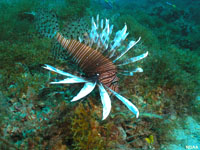 Fig. 14-27. Lionfish, native to the tropical Pacific, were introduced the Caribbean by pet owners who purchased them and then decided to turn them loose when they didn't want them anymore. In the tropical parts of the Atlantic Ocean basin, these toxic beasts have no predators to control their population, and they are contributing to wiping out populations of some native species. |
||
Unfortunately, human activities are now the primary cause of extinctions in many parts of the world. Global environmental changes, expansion of agricultural lands and urban development, and irresponsible exploitation are driving forces of extinction. |
|||
In our modern world, zoos, arboretums, and wilderness preserves are becoming the only refugia for many species. |
|||
| Collectively, we must face the fact that in most places around the world, without sustainability, humans are both exotic and/or invasive species! |
| Distribution of Organisms - how are they distributed throughout an environmental setting? i. Random: rare in marine environment ii. Uniform: more common than random. Examples: eels in holes or penguins on nests iii. Clustered: most common schooling fish. Examples clusters of barnacles and mussels on rocks. iv. Zoned: species or community of species living together in a limited geographic range defined by physical and biological factors. Examples: oyster reef along an estuary with a limiting range in salinity. Most organisms in marine environment are ZONED or CLUSTERED. |
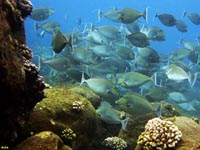 Fig. 14-28. School of unicorn fish on a Hawaiian reef. |
Symbiotic Relationships* Mutualism: benefits both host and symbiont.Example: Anemone and the anemone fish; fish cleans and feeds anemone, stays with anemone for protection – fish can’t be stung (clown fish) (Figure 14-29) * Commensalisms: no effect on host, benefits symbiont. Example: Shark and pilot fish (pilot fish eats leftovers). Or barnacles attached to a humpback whale (Figure 14-30). * Parasitism: Harms host, benefits symbiont. Examples: Parasites in tuna. Humans catching and eating tuna (with parasites). |
 Fig. 14-29. Clown fish living in a mutual relationship with a sea anemone. |
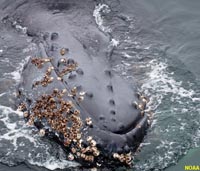 Fig. 14-30. Barnacles attached to a humpback whale. |
Evolution in Marine EnvironmentsPhysical, chemical, and biological factors drive evolution in marine communities in the oceans and coastal waters. The life mission of any species is to eat, survive, and reproduce (Figure 14-31). Every species is adapted to a limited range of physical, chemical, and biologic factors. When the conditions of the physical environment are ideal, a species, or community of species, can thrive and expand. However, if environmental changes occur that affect the range of factors they can tolerate, populations will decline from such factors of loss of body mass, reduced reproduction, diseases, and attrition from competition. Collapses in populations result in isolation of groups of individuals. These isolated groups, if they don't go extinct, become the nucleus of a subsequent population that may evolve into a new species over time, perhaps better adapted to expand their populations when environmental conditions become favorable. The ability to move or migrate in search of more favorable conditions is an important factor. Charles Darwin's famous synopsis, survival of the fittest basically means: if you can't compete, your options are "adapt, move, or die!" |
 Fig. 14-31. How evolution works. |
What is the carrying capacity for Humans on Earth?Human consumption and environmental interactions are the most influential driving force affecting species evolution and extinction in the world today. Humans have been extremely successful in their ability to adapt to new environments and to "eat, survive, and reproduce." Humans have essentially eliminated many threats (physical and biological) that have allowed the global human population to rise (through advances in agriculture, medicine, housing, transportation, technology, etc.). However, these eliminations of threats have often resulted in new threats (mostly competition within our own species for land and resources). Consider that it took all of human history until about the year 1804 to reach a population of 1 billion. The next billion was added around 1927. Since then the global population is doubling with each generation. The amount of material and space consumed by humans have also been roughly doubling with each generation.The problem is that Earth has limited resources. Every human has an impact related to both environmental changes and to competition (with other humans and with other species). The environmental effects of unmitigated human consumption of land and natural resources by the growing human populations around the world are becoming increasingly obvious. Can "we" (humanity) collectively adapt? What role do we have as individuals in facing global environmental problems? What are the roles of governments, corporations, and societal organizations? What defines "success" and "failure" (and by "who")? |
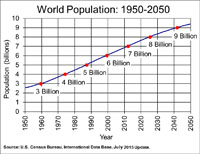 Fig. 14-32. Past and projected future human population growth. Question: how many humans can the world sustain, and at what cost to the environment? |
| Chapter 14 quiz questions |
